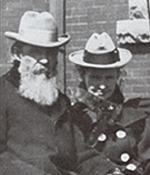John Henry Fairbank
Inventor of the jerker-line system
John and Edna Fairbank
John Henry Fairbank was born in Rouse's Point, New York in 1831. His father died when he was only eleven years old, and he had no brothers or sisters. At the age of 21, John left for Niagara Falls, where he met Edna Chrysler. He and Edna were married in 1855. Around this time, John was working for the Great Western Railway Company as a surveyor. In 1858 he was hired by Julia Macklem to survey land which she had purchased in the oil patch of Lambton County. She had purchased this land from Charles Nelson Trip.
It was on this surveying trip that John's love for the oil business was born. He returned to London, Ontario and put $10.00 down on a plot of land in Lambton County. He built a shack in Oil Springs where he began to dig for oil. His earliest oil related business venture included traveling between London and St. Thomas, Ontario selling machine lubricating oil.
Fairbank's wife, Edna, did not join him in Oil Springs at this time, but his mother and youngest son, Charles, came to live with him.
It was John Fairbank who devised the idea of using the river to transport his barrels of oil to Lake St. Clair, enabling him to bypassing the muddy roads of Enniskillen. The barrels were then loaded on ships for export. In 1862, Fairbank joined with 300 other oilmen to form the Canada Oil Association of Oil Springs. This was one of their many attempts to control fluctuating oil prices.
At this time, all wells were powered individually, which was rather expensive, inefficient, and difficult to maintain. Fairbank introduced the idea of the jerker-line system for powering his fields. He devised a way whereby he could hitch up several of his wells to one power source. By attaching wells this way, he could run eighty or ninety wells from one boiler and two engines. Once successfully proven in Lambton County, this innovation was soon introduced to the Pennsylvania oilfields, and ultimately spread around the globe. At this time, oil producers were trying to find ways to refine their product. Rudimentary refining units were often set up in the fields. They were simply stills, which were highly dangerous. Many blew up, and people were often injured or killed.
Fairbank purchased land in Petrolia in late 1865. He built a white frame house for him and his family. Edna and his older son, Henry Addington, joined him there the following May. John and Edna had their last child while living in Petrolia. They had a daughter who they named May. Their oldest son, Henry, attended the University of Toronto where he was training to become a doctor, until he took his own life. The younger son, Charles, was one of the original 18 cadets to enter the Royal Military College in Kingston, Ontario.
Fairbank partnered up with Benjamin Van Tuyl in 1865, and opened a grocery and liquor store, which later expanded into hardware and oil well supplies. Fairbank also bought and sold real estate and traded in lumber. In 1869 he joined with Leonard Vaughn to set up Petrolia's first bank, hauling a building from Oil Springs to Petrolia, which later became known as the Little Red Bank. Thirteen years later Fairbank, Jacob Englehart, and others joined together to create the Crown Savings and Loan Company.
In 1866 Fairbank organized a group of oil producers to build an eight-kilometer spur line railway from the Great Western depot at Wyoming. This helped the local economy enormously. In 1868 major oil producers, including Fairbank, created the Crude Oil Association.
John entered local politics and was elected three times to council. He served as reeve from 1868 to 1870, and was elected as the Federal Liberal Member of Parliament in 1882.
In 1873 John formed the Home Oil Company in an attempt to increase producer's leverage. A refinery was erected in Petrolia, which survived eight years, with Fairbank as its president. James Miller Williams was also a shareholder in this company.
John Henry Fairbank lived relatively modestly in his white frame house, until 1889, when he began construction of the mansion, Sunnyside.
In the 1870's he was appointed as Fire Chief, a position he held until he retired in 1889.
This amazing entrepreneur also had an interest in the railway business, and with John W. Sifton, became involved in financing the Canadian Pacific rail line from west of Lakehead. Apparently, he even travelled to Northwestern Ontario to oversee part of the construction.
Fairbank's health began to fail in 1912 and he passed away in February of 1914. “On the day of his funeral businesses closed in tribute, and hundreds turned out to pay their respects. Flags were dropped to half-staff, and the town band played the Death March”. (Gary May, Hard Oiler!, p. 215)



 Subscribe to this page
Subscribe to this page